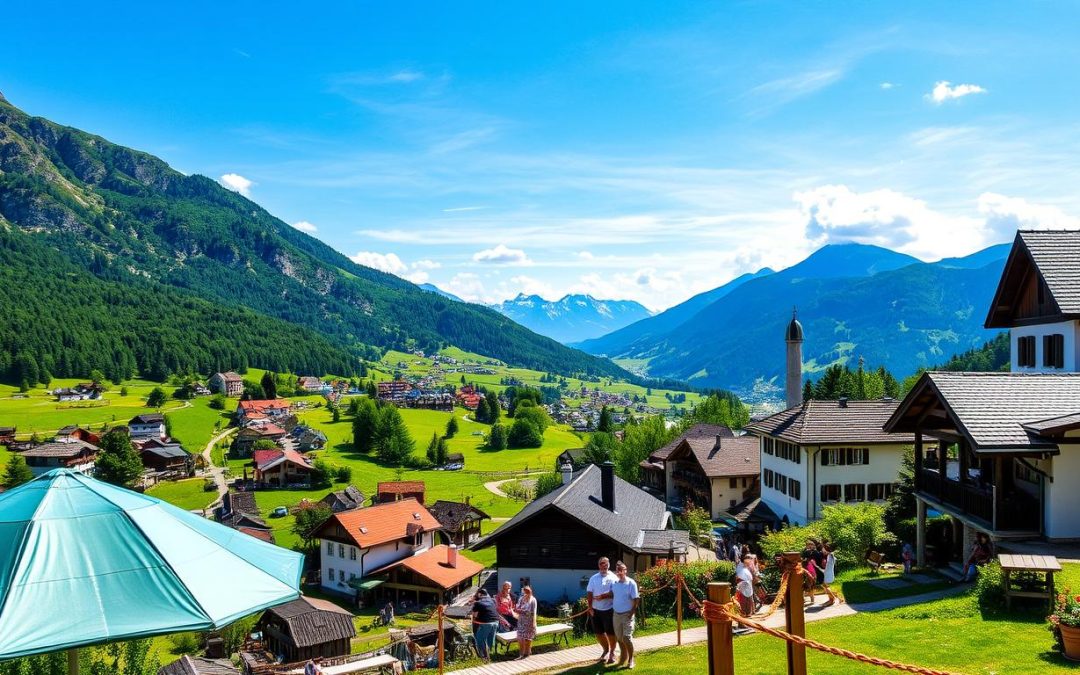Have you ever wondered how a small European country can have so many languages? Austria shows us that language is more than just words. It’s a window into a country’s culture and history.
In Austria, language is a big part of who we are. German is the main language, spoken by most people. But there’s more to it than just standard German. There are local dialects, minority languages, and a mix of cultures that make communication rich and varied.
Austria’s language story is complex. It’s shaped by history, local differences, and cultural diversity. For example, Austro-Bavarian dialects are spoken by millions. And there are minority languages in certain areas. This shows how deep and varied Austria’s language heritage is.
Key Takeaways
- German is the primary official language in Austria
- Over 93% of Austrians consider German their mother tongue
- Approximately 250 languages are spoken across the country
- Regional dialects play a significant role in Austrian communication
- Minority languages reflect Austria’s diverse cultural background
Overview of Austria’s Linguistic Landscape
Austria is a fascinating mix of languages, with German being the main one. But the country’s many languages show its rich culture. This comes from history and people moving here.
Current Language Demographics
In Austria, almost everyone speaks German. About 90% of people say it’s their first language. But, there are also many other languages spoken by minority groups and immigrants.
- German: Primary language for 90% of population
- Turkish: Largest immigrant language group
- South Slavic languages: Significant presence
- Hungarian: Concentrated in Burgenland region
Historical Language Evolution
Austria has worked hard to keep its languages alive. The country officially recognizes many minority languages. These include:
- Hungarian
- Slovenian
- Burgenland-Croatian
- Czech
- Slovak
- Romany
- Sign Language
Language Distribution Across Regions
Language use varies across Austria. In big cities like Vienna, you can hear over 250 languages. Young people and professionals often speak many languages.
“Language is the roadmap of a culture. It tells you where its people come from and where they are going.” – Rita Mae Brown
German as the Official Language
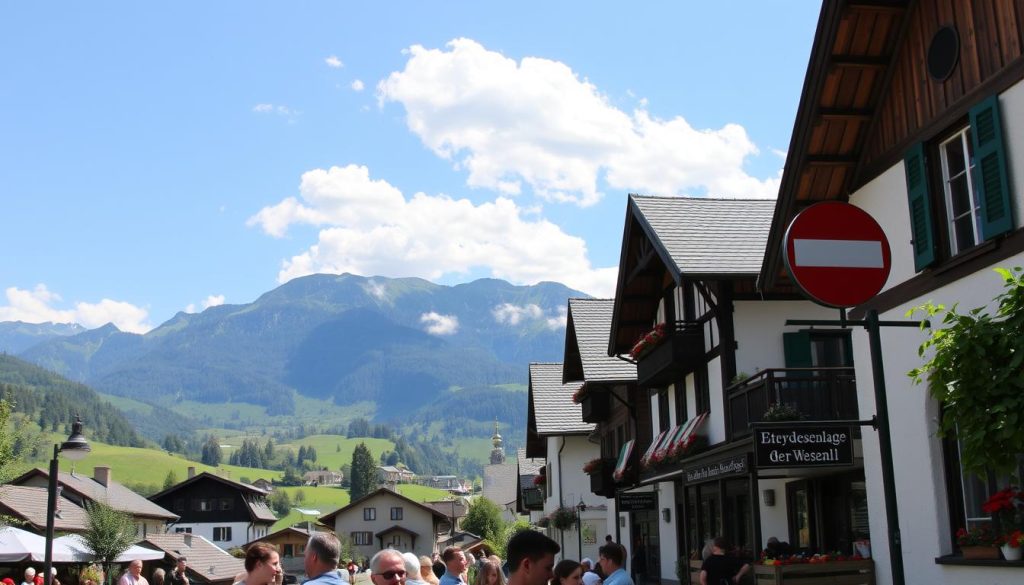
Austria’s language scene is all about German, the official tongue and main way to talk. German ties people from all over the country together. It’s a big part of what makes Austria, Austria.
German is more than just a way to communicate in Austria. It’s a key part of the culture. Almost 95% of the people speak German first, making it the country’s main language.
“Language is the road map of a culture. It tells you where its people come from and where they are going.” – Rita Mae Brown
Here are some important facts about German in Austria:
- It’s used in government work.
- It’s the main language in schools.
- It’s the top language in media and public talks.
- It’s crucial for work and social life.
Austrian German has its own special ways of speaking, different from German in other places. These differences show the rich culture of Austria’s many areas.
| Language Statistic | Details |
|---|---|
| Native German Speakers | 95 million |
| Official Language Status | 7 countries, including Austria |
| Austrian German Speakers | Approximately 8.9 million |
Learning about German helps us understand Austria’s culture and language. Whether you love languages or are just visiting, knowing these details makes your experience richer. It connects you to this lively Central European country.
Austrian German: Unique Characteristics and Features
Austrian German is more than just a dialect. It’s a unique language with its own special traits. It’s the only pluricentric language recognized by international law. This makes it a key part of linguistic diversity.
Since 1951, Austrian German has had a standardized form. The Österreichisches Wörterbuch, published by the Austrian Federal Ministry of Education, Arts and Culture, defines it. This shows how important the language is to Austrian culture.
Distinctive Vocabulary Variations
Austrian German has its own special words. These words show its rich cultural background. Some interesting differences include:
- Food terms: “Erdapfel” instead of “Kartoffel” for potato
- Seasonal words: “Jänner” for January and “Feber” for February
- Everyday language: “Stiege” meaning stairs
Grammar Peculiarities
Austrian German’s grammar is different from standard German. You’ll find unique features like:
- Using auxiliary verb ‘sein’ in state-expressing verbs
- Not often using the simple past tense
- Special ways of forming plurals and comparing adjectives
Linguistic Influences
Austrian German has words borrowed from Slavic languages, French, and Italian. This makes it rich and diverse. With many regional dialects, it shows the local influences that make it lively.
“Language is the road map of a culture. It tells you where its people come from and where they are going.” – Rita Mae Brown
Austro-Bavarian Dialects
Austria is known for its rich linguistic diversity. Austro-Bavarian dialects are a big part of this. They are more than just a way to speak. They are a link to the past that connects people across the country.
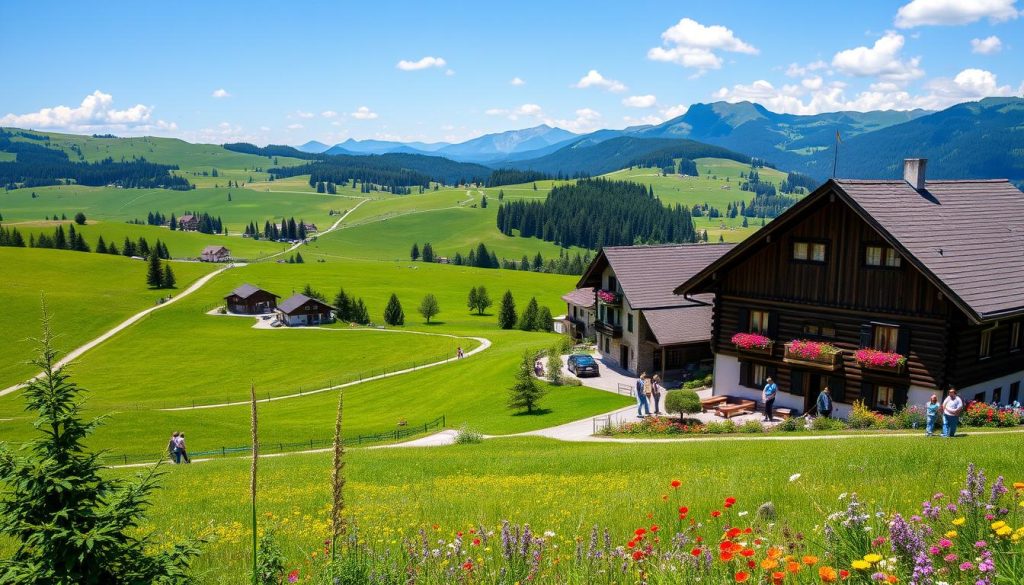
The Bavarian dialect family is quite interesting. Let’s look at what makes these dialects unique:
- Spoken by about 7 million Austrians
- There are three main dialect groups:
- Northern Bavarian
- Central Bavarian
- Southern Bavarian
- UNESCO calls it a vulnerable language
“Language is the road map of a culture. It tells you where its people come from and where they are going.” – Rita Mae Brown
Exploring Austrian languages shows how important being multilingual is. While standard German is official, Bavarian dialects are still alive in rural areas. They keep local traditions and ways of speaking alive.
| Dialect Region | Approximate Speakers | Linguistic Characteristics |
|---|---|---|
| Lower Austria | 2.5 million | Strong Central Bavarian influence |
| Upper Austria | 1.8 million | Distinct pronunciation patterns |
| Styria | 1.2 million | Unique vocabulary variations |
| Tyrol | 0.7 million | Mountain dialect with specific intonations |
Learning about Austro-Bavarian dialects opens a door to Austria’s rich culture. These dialects show the country’s complex history and diverse regions.
Alemannic German in Vorarlberg
Vorarlberg, in Austria’s west, is special for its Alemannic German dialect. This dialect adds to Austria’s language variety, making it unique.
Geographic Distribution
Alemannic German is mainly spoken in two places in Austria:
- Vorarlberg state
- Reutte District of Tyrol
Linguistic Features
The Alemannic dialect has its own special traits. It’s different from standard Austrian German. Some key features include:
- No set way to write it
- Many ways to make words smaller:
- -le in northern areas
- -el in the west
- -li in the south
Cultural Impact
Alemannic German is key to local culture. With 300,000 speakers in Austria, it’s more than a language. It’s a symbol of regional traditions.
Alemannic is not just a language, but a living connection to the region’s rich heritage.
| Linguistic Characteristic | Details |
|---|---|
| Global Speakers | Approximately 10 million |
| UNESCO Language Status | Vulnerable |
| Vorarlberg Population | Over 370,000 |
Learning about Alemannic German opens a door to Austria’s rich language scene. It shows how language and identity blend in this lively Alpine area.
Austria: Official and Widely Spoken Languages
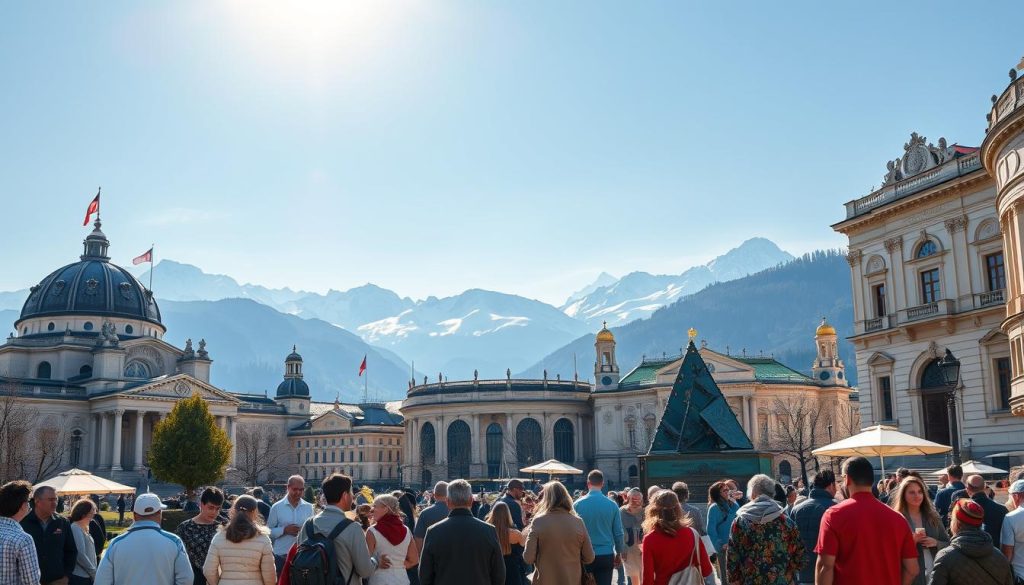
Austria’s language scene is rich and varied, with more than just German. German is the main official language, but Austria also celebrates many other languages. This shows its complex cultural background.
Looking at official language stats, we see:
- German is spoken by about 88% of people
- Minority languages like Hungarian, Slovenian, and Croatian are recognized
- English is spoken by around 73% of Austrians
Austria values language diversity. It protects minority languages in certain areas. This helps Croatian, Slovenian, and Hungarian communities keep their culture and language alive.
“Language is the roadmap of a culture. It tells you where its people come from and where they are going.” – Rita Mae Brown
Immigration has also made Austria’s language scene more diverse. Turkish speakers make up about 18% of the population, and Serbian is spoken by 2.9%. Vienna and other cities are especially linguistically diverse.
Many Austrians are multilingual. About 56% can speak at least two languages. This shows Austria’s strong global language skills.
Minority Languages and Their Status
Austria is a great example of linguistic diversity. It protects the rich variety of minority languages. The country fights for language rights and keeps cultures alive.
The nation officially recognizes six national ethnic minorities. Each has its own unique language:
- Slovene
- Croatian
- Hungarian
- Czech
- Slovak
- Romani
These minority languages get special protection under the Ethnic Group Act of 1976. This law gives them rights in education, public services, and culture. It helps them keep their cultural identities strong.
“Language is the roadmap of a culture. It tells you where its people come from and where they are going.” – Rita Mae Brown
This means bilingual signs in areas with many minority speakers. Schools teach in native languages. And official talks respect all languages. For example, Slovene is official in Carinthia and Styria. Burgenland supports Croatian speakers well.
Austria’s love for language diversity goes beyond laws. It has signed the European Charter for Regional or Minority Languages. This shows its active role in saving these important cultural voices.
Language Rights and Protection
Austria works hard to protect many languages through strong policies and education. This shows its deep respect for different cultures and communities.
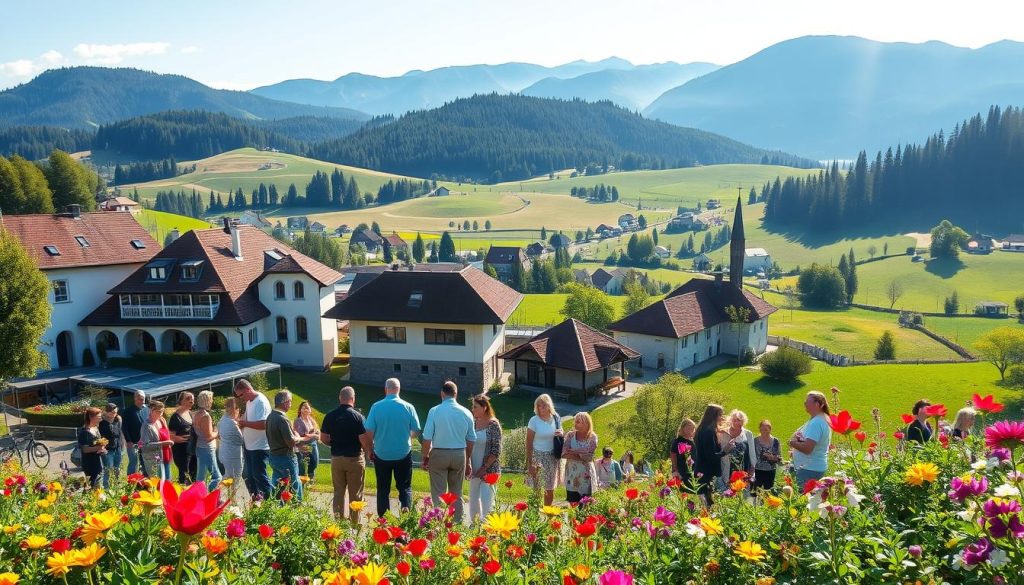
The country has a solid legal base for protecting languages. This includes:
- European Charter for Regional or Minority Languages
- National constitutional provisions
- State-level language protection laws
Legal Implementation Framework
Austria joined the European Charter for Regional or Minority Languages on June 28, 2001. This shows its commitment to keeping minority languages alive. The charter protects languages like:
- Croatian (Burgenland)
- Slovene (Carinthia and Styria)
- Hungarian (Burgenland and Vienna)
- Czech (Vienna)
- Slovak (Vienna)
- Romani (Burgenland)
Educational Provisions
In Austria, language rights go beyond just laws. The country has strong education plans to help minority languages. Schools in areas with many minority speakers offer bilingual education.
“Language is the roadmap of a culture. It tells you where its people come from and where they are going.” – Rita Mae Brown
These policies aim to create a place where everyone feels valued. They help everyone understand and respect each other’s languages and cultures.
Foreign Languages in Modern Austria
Austria’s language scene goes beyond just German, showing off amazing multilingualism and diversity. You’ll find a mix of foreign languages that show the country’s cultural depth and global ties.
English is a big deal in Austria, with about 40% of people speaking it well. This skill is key for:
- Business talks
- International tourism
- Academic exchanges
- Professional networking
Other languages like French and Italian are also big in Austria. Around 7% speak French, and many know Italian too.
“Language is the roadmap of a culture. It tells you where its people come from and where they are going.” – Rita Mae Brown
The education system in Austria focuses on teaching foreign languages. It knows that speaking many languages is important in today’s world. Turkish, Serbian, and Hungarian are also important, adding to Austria’s language mix.
Globalization and immigration have changed Austria’s language scene a lot. They’ve brought in new languages and made the country’s language scene more lively and diverse.
Language Education System
Austria’s language education system is advanced. It focuses on teaching many languages and understanding different cultures. The country’s schools use a wide range of methods to teach languages, not just in classrooms.
The system in Austria supports learning many languages. Students get to try out different ways of learning languages. This helps them improve their language skills.
- English is usually the first foreign language taught in schools
- Language policies help students learn many languages
- The curriculum offers many chances to learn languages
Some key points about Austria’s language education are:
| Education Level | Language Focus | Weekly Hours |
|---|---|---|
| Compulsory Secondary School | German Proficiency | 16 total hours |
| Secondary Education | Modern Foreign Languages | 14 total hours |
The Council of Europe’s Language Education Policy Profile has shaped Austria’s approach. This framework helps understand language education fully. It includes national languages, regional dialects, and skills for international communication.
“Language learning is not just about communication, but about understanding cultural diversity.” – Austrian Educational Expert
Students in Austria learn in a lively environment. This prepares them for talking with people from all over the world. The system mixes traditional learning with new ways to teach languages at all levels.
- Multilingual education programs are available in minority language regions
- There’s a big focus on using languages in real-life situations
- Teachers keep learning to improve their language teaching skills
Austria’s focus on language education and multilingualism helps students. They become skilled and confident communicators in our connected world.
Urban vs. Rural Language Usage
Austria’s language scene is full of interesting contrasts between city and countryside. The country’s dialects show a wide range of languages, influenced by many factors. These factors make city and country ways of speaking very different.
In big cities like Vienna, people often speak standard German more. Studies show that about 70% of what people say in the city is standard German. Only 30% is local dialect.
Metropolitan Language Patterns
Big cities have their own special way of speaking. At work, most people in cities prefer to speak standard German. This is true for about 80% of city workers.
- Standard German dominates urban communication
- Professional contexts prioritize uniform language
- Multilingualism rates higher in metropolitan areas
Rural Dialect Preservation
In rural areas, the opposite is true. These places keep their local dialects alive. About 60% of what people say in these areas is traditional dialect.
Sociolinguistic Factors
Many things shape how people speak:
| Factor | Urban Impact | Rural Impact |
|---|---|---|
| Dialect Retention | 20% among youth | 65% among older generations |
| Language Preference | Standard German | Regional Dialects |
| Multilingual Rate | 55% | 30% |
“Regional dialects provide a sense of home without significantly diverging from standard language variations.” – Austrian Linguistic Research Institute
Learning about these differences helps us see how rich Austria’s language scene is. Language is a key part of culture and keeps changing.
Impact of Immigration on Language Diversity
Immigration has changed Austria’s language scene a lot. Since the 1960s, guest worker programs have brought in many cultures and languages. This has made Austria a more diverse place.
Immigration has made Austria’s languages more varied. Some of the main languages from immigrants include:
- Turkish speakers (2.3% of population)
- Serbian speakers (2.2% of population)
- Bosnian speakers (1.9% of population)
“Language is the roadmap of a culture. It tells you where its people come from and where they are going.” – Rita Mae Brown
These languages have grown and become part of Austrian cities. Places like Vienna are now full of different languages. Here, language policies are always changing.
| Immigrant Language | Percentage of Population | Estimated Speakers |
|---|---|---|
| Turkish | 2.3% | Up to 500,000 |
| Serbian | 2.2% | Up to 500,000 |
| Bosnian | 1.9% | Approximately 150,000 |
Today, Austria’s language policies are more open to diversity. They support multilingual education and community programs. This helps everyone understand and connect better.
Conclusion
Austria’s language diversity shows a rich cultural scene. German is the official language, with about 130 million native speakers worldwide. This makes Austria’s language very important globally.
The country balances keeping traditional dialects and using modern languages. This balance is key to its language ecosystem.
Austria’s language policies support its diverse languages, like Burgenland Croatian and Slovene. Over 50% of Austrians speak more than one language. This shows Austria’s advanced communication skills.
Vienna is like Silicon Valley for its innovation and language skills. Here, business meets language expertise.
Austria leads in adapting to changing global communication. Its nine German dialects show cultural strength. Even though only a third speak Standard German well, everyone’s language skills keep language alive.
Exploring Austria’s language shows the mix of old and new. From Vorarlberg’s Alemannic dialects to big city languages, Austria uses language to preserve culture and communicate.
The above is subject to change.
Check back often to TRAVEL.COM for the latest travel tips and deals.
Here are some Tours & Sightseeing suggestions that might pique your interests!
